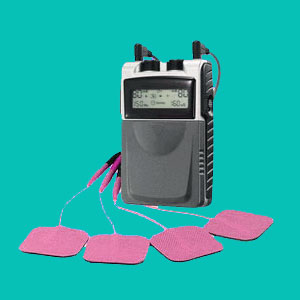
TENS for herniated discs is the practice of using electrotherapy delivered by a device known as a transcutaneous electrical nerve stimulation unit. TENS is used for many different back pain conditions and remains a highly controversial treatment, despite its popularity with back care providers around the world.
TENS is one of the most popular varieties of home treatment for herniated discs. Since most units are small and portable, patients can enact much needed pain relief on the go, at work or anywhere they might need it. This makes TENS an extremely flexible therapy option.
This article will describe the TENS treatment process and will focus on the benefits and limitations of electrotherapy.
TENS for Herniated Discs Explained
Electrostimulation delivers mild electric current to the affected area of the back using small transcutaneous electrode pads. TENS devices can produce low frequency and high frequency stimulation, depending on the specific needs of the patient.
Typically, this treatment is combined with other conservative approaches to herniated disc pain relief, such as chiropractic, massage or even spinal decompression. Most patients relax and receive electrical stimulation for between 15 to 60 minutes at a time.
TENS is thought to work by disrupting nerve signals which bring pain messages to the brain. Neurological functions are electrical in nature and the mild electric shock provided by a TENS unit might prevent the accurate transmission of pain messages. Additionally, TENS might help the body to release endorphins, which are naturally occurring anti-pain chemicals produced in the brain.
Effectiveness of TENS for Bulging Discs
Patients who subscribe to the theory of TENS and are definitely suffering from nerve-related disc pain, such as pinched nerves or sciatica, might enjoy some benefits from electrostimulation therapy. As with many treatment options, believing that the approach will work will assist in increasing the effectiveness of the therapy considerably.
Many doctors question whether electrotherapy does anything at all, since statistical evidence compared to placebo techniques is generally inconclusive. One thing is absolutely sure. TENS will not change the disc anatomy and will certainly not cure the condition. The best a patient might hope for is purely temporary symptomatic relief from their pain.
However, being that risks are almost nonexistent, when used as indicated, TENS might be far better suited as a safe pain management system than drugs could ever be.
Experience Using TENS for Herniated Discs
One of my early chiropractors was a big TENS advocate and had me endure countless hours of sitting in an uncomfortable chair and getting zapped by this annoying and useless therapy. I never enjoyed even one bit of relief from this treatment option and found it to be irritating and unpleasant. Other patients have had completely different experiences and swear by the excellent curative powers of their TENS units.
TENS devices are certainly big business, with millions being sold every year for healthy profits. Care providers love them, since they offer an additional income stream which does not even require their attention whatsoever. An assistant can set the patient up on the device and then leave while the poor soul is zapped for the better part of an hour.
Do I sound critical? Yes. I am not a fan of this therapy modality. However, you might have a completely different view of TENS once you try it for yourself. The cost is low, risk is minimal and your results may be better than expected.
Herniated Disc > Herniated Disc Treatments > TENS for Herniated Discs




